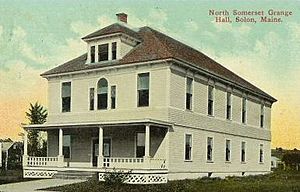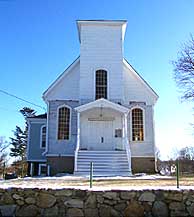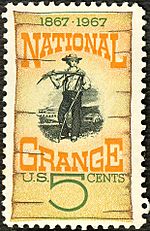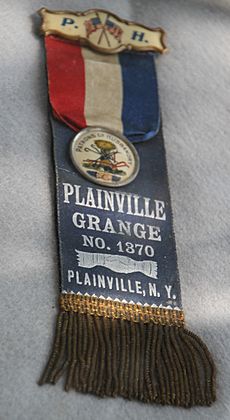National Grange of the Order of Patrons of Husbandry facts for kids

Promotional poster, ca. 1873, that offers a "gift for the grangers"
|
|
| Formation | December 4, 1867 |
|---|---|
| Founder | Oliver Hudson Kelley William Saunders Francis M. McDowell John Trimble Aaron B. Grosh John R. Thompson William M. Ireland Caroline Hall |
| Founded at | Washington, D.C. |
| Type | Advocacy group Fraternal organization |
| Purpose | Agrarian interest group Agricultural education Grassroots organizing |
| Headquarters | National Grange Headquarters Building 1616 H Street NW Washington, DC |
| Origins | Farmers' movement |
|
Region served
|
United States |
|
Membership
|
~150,000 |
|
National President
|
Betsy Huber |
|
National Vice President
|
Christine Hamp |
|
Executive Committee Chair
|
Lynette Schaeffer |
|
Executive Committee Secretary
|
Susan Noah |

The Grange, also known as The National Grange of the Order of Patrons of Husbandry, is a social group in the United States. It helps families work together to improve life for farmers and their communities. Founded in 1867 after the American Civil War, it is the oldest national group supporting farmers in the U.S.
The Grange has worked hard to influence laws. For example, it pushed for the Granger Laws to make railroad shipping cheaper. It also helped create Rural Free Delivery, which brought mail directly to people's homes in the countryside.
In 2005, the Grange had about 160,000 members. It had groups in 2,100 towns across 36 states. Its main office is in Washington, D.C. Many small towns still have a Grange Hall. These halls often serve as important community centers for farming areas.
Contents
History of The Grange
After the American Civil War, the U.S. Department of Agriculture asked Oliver Hudson Kelley to visit Southern states. His job was to find ways to help farmers there. Kelley noticed that farmers in the South and West used old-fashioned methods. He saw a need for a group that could bring people together. This group would help farmers learn new ways and work together.
After talking with others, the Grange was created. The first local Grange group started in 1868 in Fredonia, New York. Seven men and one woman helped start the Grange. They were Oliver Hudson Kelley, William Saunders, Francis M. McDowell, John Trimble, Aaron B. Grosh, John R. Thompson, William M. Ireland, and Caroline Hall. By 1873, all the local groups joined under one National Grange in Washington, D.C.
Growing Membership and Early Goals
The Grange grew very quickly. Membership jumped from 200,000 in 1873 to over 858,000 by 1875. Many local Grange groups started making political statements. They especially wanted to control the high costs of railroad shipping.
The Grange was special for its time because it welcomed women and teenagers. Anyone old enough to help with farm work (around 14 to 16 years old) could join. To show how important women were, the Grange required that four of its main leadership roles had to be held by women.
As more people joined, the national Grange received a lot of money from membership fees. Many local groups started their own stores. These stores were like co-ops, where members could buy goods together. However, some money problems and fast growth led to a big drop in members. By the early 1900s, the Grange recovered. Its membership became steady again.
The Grange movement supported politicians who wanted to control railroad and grain storage prices. They also helped create ideas like the Cooperative Extension Service. This service teaches farmers new techniques. They also supported Rural Free Delivery (mail to rural homes) and the Farm Credit System (loans for farmers).
A big success for the Grange was the Supreme Court case Munn v. Illinois (1877). The court decided that grain warehouses served the "public interest." This meant they could be regulated by law. However, this decision was later changed by the Supreme Court in 1886. The Grange also supported the idea of avoiding alcohol. They wanted people to directly elect Senators. They also supported women's suffrage, which gave women the right to vote.
Grange and Politics
The Grange itself was not a political party. However, its members were active in politics, especially in the Midwest in the late 1800s. They often joined reform movements to improve things for farmers.
Fewer Members Over Time
Grange membership has gone down a lot. This is because fewer Americans are farmers today. In the early 1900s, about one-third of people were farmers. Now, it's less than two percent. Between 1992 and 2007, the number of Grange members dropped by 40%. The state of Washington has the most members, with about 13,000.
The Grange Today

As of 2013[update] the Grange still works for farmers' rights. This includes issues like fair trade and farm policies. In 2006, the Grange explained its goals. It said it helps people and families grow. This helps build stronger communities, states, and the nation. They do this through friendship, helping others, and working on laws.
In 2019, the National Grange updated its mission statement:
The Grange strengthens individuals, families and communities through grassroots action, service, education, advocacy and agriculture awareness.
The Grange does not support any political party or candidate. It only supports ideas and policies. Even though it started for farmers, the Grange now works on many different issues. Anyone is welcome to join the Grange.
The Junior Grange is for children aged 5 to 14. Regular Grange membership is for anyone 14 or older. There is also a Grange Youth group for members aged 13.5 to 35.
In 2013, the Grange supported a letter to Congress. This letter asked for more legal immigration. It also asked for a way for workers from other countries to become legal residents. Now, the Grange focuses on expanding a program called H-2A visas. This program helps bring farm workers to the U.S. legally. They want immigration laws to be followed. But they also want to make sure there are enough workers for farms.
Grange Traditions and Meetings
When the Grange began in 1867, it used some traditions from another group called Freemasonry. This included special ways of meeting and passwords. These passwords helped keep out people who might spy for the railroads. The Grange also used ideas from old Greek, Roman, and Bible stories. Small, pretend farm tools are often shown at Grange meetings. Elected leaders open and close each meeting.
There are seven levels, or "degrees," of Grange membership. Each degree has a ceremony. These ceremonies are often linked to the seasons and important ideas. In recent years, the Grange has started having more public meetings. They no longer meet in secret. But they still respect their history and use some of their old traditions.
How The Grange is Organized
The Grange has different levels, from local groups to a national organization. At the local level, there are community Granges. Everyone who joins is part of at least one local group. In most states, several local Granges form a larger group called a Pomona Grange. These usually include all the local groups in a county.
Next are the State Granges. These groups are very active in politics at the state level. State leaders, called Masters or Presidents, manage the local and Pomona Granges. Thirty-five State Granges, plus one in Washington, D.C., make up the National Grange. The National Grange speaks for most Grange members. It works to influence laws on a much larger scale. It also oversees the Grange's traditions. The Grange is a grassroots organization. This means that most of its ideas and policies start at the local level.
The Grange's motto is In necessariis unitas, in dubiis libertas, in omnibus caritas. This means "In essentials, unity; in non-essentials, liberty; in all things, charity." The word "grange" comes from a Latin word for grain. It is related to a "granary," which is a place to store grain, or simply a farm.
Famous People in The Grange
Many well-known people have been part of the Grange. Here are a few:
- D. Wyatt Aiken (1828–1887), a U.S. Representative from South Carolina.
- Harold J. Arthur (1904–1971), a Governor of Vermont.
- Nahum J. Bachelder (1854–1934), a Governor of New Hampshire.
- Charles J. Bell (1845–1909), a Governor of Vermont.
- Robert Bergland (1928–2018), a U.S. Secretary of Agriculture.
- Charles F. Brannan (1903–1992), a U.S. Secretary of Agriculture.
- Ezra S. Carr, a California State Superintendent of Public Instruction.
- Norman Jay Coleman (1827–1911), the first U.S. Secretary of Agriculture.
- Henry C. Groseclose, who founded the Future Farmers of Virginia and Future Farmers of America.
- Aaron B. Grosh (1803–1884), one of the founders of the National Grange.
- Caroline A. Hall (1838–1918), one of the founders of the National Grange.
- William M. Ireland (???–1891), one of the founders of the National Grange.
- Oliver Hudson Kelley (1826–1913), the main founder of the Grange.
- Evander M. Law (1836–1920), a Confederate general who helped organize the Alabama Grange.
- David Lubin (1849–1919), who founded the California Fruit Growers Union.
- Cyrus G. Luce (1824–1905), a Governor of Michigan.
- James W. Marshall (1810–1885), who discovered gold in California.
- Francis Marion McDowell (1831–1894), one of the founders of the National Grange.
- James Nesmith (1820–1885), a U.S. Senator from Oregon.
- Krist Novoselic (born 1965), the bass guitarist for the band Nirvana.
- Gifford Pinchot (1865–1946), a Governor of Pennsylvania.
- Frederick Robie (1822–1912), a Governor of Maine.
- Robert P. Robinson (1869–1939), a Governor of Delaware.
- Norman Rockwell (1894–1978), a famous American painter.
- Eleanor Roosevelt (1884–1962), a First Lady of the United States.
- Franklin D. Roosevelt (1882–1945), the 32nd President of the United States.
- William Saunders (1822–1900), a botanist and one of the founders of the National Grange.
- John R. Thompson (1834–1894), one of the founders of the National Grange.
- John Trimble (1831–1902), one of the founders of the National Grange.
- Harry S. Truman (1884–1972), the 33rd President of the United States.
See also
 In Spanish: The Grange para niños
In Spanish: The Grange para niños
- List of Grange Hall buildings
- Order of the Sovereigns of Industry




